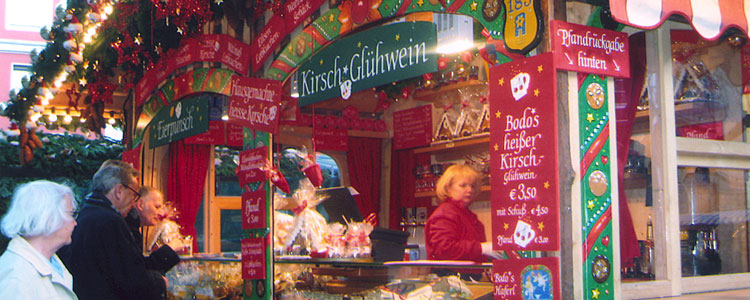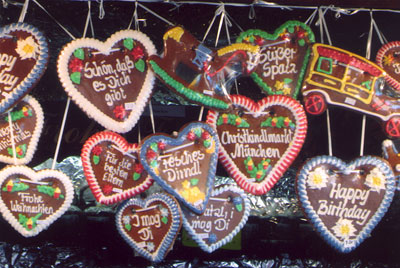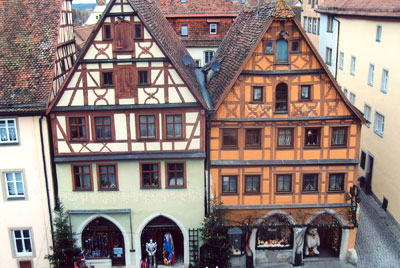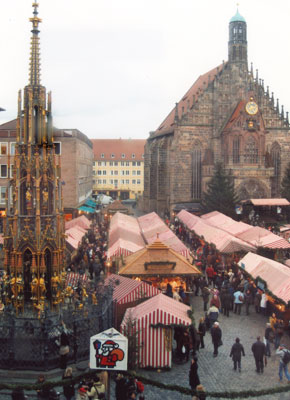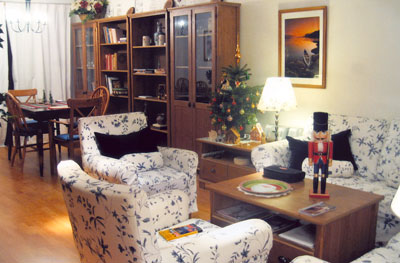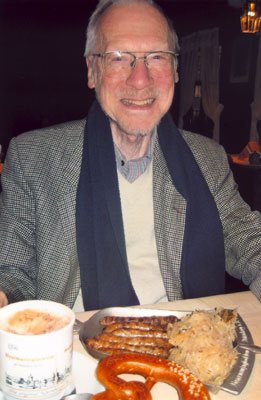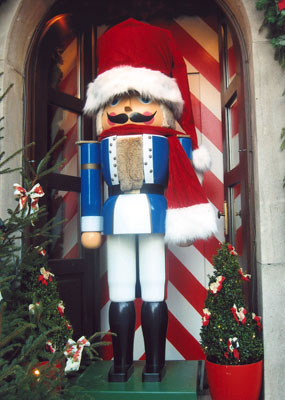Reveling in the Christmas spirit – Germany during the holidays
I am explaining this so you understand why, for the past two decades, at least, I have wanted to visit some of the Christmas markets in Europe, especially those in Germany, which are reputedly among the best. Something always intervened — my job, Paul’s job, family responsibilities — and a visit to the Christmas markets was always postponed. That is, until December 2009, when the opportunity finally arrived and we grabbed it.
By Julie Skurdenis; Contributing Editor
I love Christmas and everything about it — the card writing, the frenzied shopping, having friends over to share Yuletide cheer, the Nutcracker performances we haven’t missed in 30 years, and putting up a live tree and decorating it with the hundreds of ornaments we’ve collected over many years.
My husband, Paul, laughingly claims I am the only one he knows who starts preparing for Christmas in the middle of summer. He exaggerates. I really don’t begin planning in the heat of a New York summer, although it is true that by Halloween, at the latest, preparations are well under way.
I am explaining this so you understand why, for the past two decades, at least, I have wanted to visit some of the Christmas markets in Europe, especially those in Germany, which are reputedly among the best. Something always intervened — my job, Paul’s job, family responsibilities — and a visit to the Christmas markets was always postponed. That is, until December 2009, when the opportunity finally arrived and we grabbed it.
Home base
We scheduled our trip for the first 16 days of December and decided to base ourselves in an apartment in Munich, planning two two-night excursions out of the city rather than traveling from city to city.
The first thing we did after arriving in Munich, following unpacking and settling into our apartment, was find a small Christmas tree. It turned out to be easy. The supermarket a block away from our apartment sold three-foot-high trees. But they came in heavy pots and Paul had to lug the tree back to the apartment over his shoulder, looking like a lumberjack.
Over the course of the next two weeks, we gradually decorated the tree with small treasures from each of the Christmas markets we visited.
The second thing we did was dress ourselves warmly. There was no snow in Munich, but chilly winds were blowing. Then we headed for Marienplatz, the heart of Munich’s Old City. It is where the Gothic 15th-century Altes Rathaus (Old Town Hall) is located, not far from the Neo-Gothic 19th-century Neues Rathaus (New Town Hall).
It is also the site of one of Germany’s best Christmas markets, the Christkindlmarkt, with hundreds of stalls crowded shoulder to shoulder in the square and along the nearby Kaufingerstrasse. There are stalls selling Christmas ornaments, toys, nutcrackers, holiday linens, decorative cookies of all types and sizes, nuts and candies, beer and Glühwein (hot spiced wine) plus more types of sausages than one could ever imagine.
Münchners come to browse and buy but also to eat — and eat. I would guess that there were more people eating than buying.
We followed their example, filling ourselves with sausage and Glühwein, and then shopped for ornaments for both our small Munich Christmas tree and our large tree back home.
During the day, Munich’s Christmas markets were just plain wonderful. At night, with Christmas lights twinkling on the stalls and the huge, 50-foot-high tree in front of the Neues Rathaus lit, the atmosphere was pure magic.
Other favorites
Steps away from the Christkindlmarkt, on Rindermarkt, is one of Munich’s most charming Christmas markets, the Kripperlmarkt (Crèche Market), where complete nativity sets as well as individual figurines are sold. Many of the sets are exquisite, carefully crafted and quite expensive, running into hundreds of dollars. We bought three small sheep, one cow and a cat to add to our nativity set back home.
Another Christmas market we loved was the one in the Englischer Garten, Munich’s largest park. There, around the aptly named Chinese Tower and a small, colorful merry-go-round, were stands selling goodies to take away or to eat there. We bought the traditional German Christmas cookie, Pfeffernüsse, getting enough to last us for our entire stay in Munich.
These were our three favorite Christmas markets. We liked the first two so much that we returned several times. But there were many more throughout the city. Of these, there are four more we recommend: the Medieval Christmas Market at Wittelsbacher Platz, where the medieval theme is evident, with wooden booths selling beautiful handcrafted items, including woolen goods and jewelry; the intimate Christmas market in the Königshof, a courtyard in the Residenz; the neighborhood Christmas market in Schwabing, where sprigs of mistletoe can be bought, and the Christmas market at Sendlinger Tor, once part of Munich’s medieval town walls.
City sights
Munich is not just a city famous for its Christmas markets, it is also a city of museums, palaces, parks and great restaurants. These we did not neglect. Here are some of our favorites.
Aside from its Christmas market, Marienplatz and its immediate vicinity is full of sights, including the onion-domed Frauenkirche, the Gothic cathedral that has come to symbolize Munich; the Glockenspiel (chiming clock with figures) on the facade of the Neues Rathaus, which plays at 11 a.m. and at noon; the over-the-top Rococo interior of the Asamkirche, built by the sculptor/artist Asam brothers and completed in 1746, and the open-air Viktualienmarkt, a superb food market offering fruit, vegetables and, of course, an enormous selection of sausages. It also sells Christmas trees and wreaths.
Two palaces not to miss are the Residenz, home of the Bavarian Wittelsbach dynasty for five centuries — with its Schatzkammer (Treasury), displaying crown jewels, and the Rococo Cuvilliés Theater, built in 1750 — and Schloss Nymphenburg, the enormous summer palace begun by Elector Ferdinand Maria in 1664 to celebrate the birth of an heir.
Among museums, these ranked as our favorites: the Alte Pinakothek, housing Old Masters (its Rubens collection is superlative); the Neue Pinakothek, displaying 19th- and 20th-century artworks; the Glyptothek, with Greek and Roman sculpture, and the Bayerisches Nationalmuseum, displaying folk art, including the finest collection of crèches we’ve ever seen — very appropriate for the time of year.
We wanted to visit the Lenbachhaus to see its collection of works by Munich expressionist painters of the Blaue Reiter (Blue Rider) group, but it’s closed for renovation until the summer of 2012.
For those interested in science, the Deutsches Museum is a must. It has a reconstruction of Galileo’s workshop with some of the original equipment used by the famous Italian scientist.
Even if you’re not going to the Englischer Garten for its Christmas market (which would be a mistake), it’s worth taking a stroll there near the Chinese Tower if the weather is mild.
As for restaurants, when we weren’t noshing in the Christmas markets or in the Viktualienmarkt, our favorite was the Augustiner Großgaststätten (27 Neuhauserstrasse), about five minutes from Marienplatz. The food is Bavarian and the beer is Augustiner, brewed since the 14th century. Prices are moderate; dinner for two, with beer, cost about €35 ($45).
On to Nürnberg
There is certainly no lack of Christmas markets in Munich, but we wanted to sample a few markets in other cities as well. We selected Nürnberg, with one of Germany’s largest Christmas markets, and Rothenburg-ob-der-Tauber, with, reputedly, Germany’s prettiest Christmas market. It’s possible to visit each on a day excursion from Munich, but we felt this would be too rushed, giving us little time to savor the markets.
We opted for two nights in each city, making a four-night, triangular trip from Munich to Nürnberg (about one hour by train) to Rothenburg-ob-der-Tauber (about 90 minutes) and back to Munich (about 2½ hours). This allowed us time for both Christmas markets and sightseeing.
The Christmas market in Nürnberg is centered in the Hauptmarkt, with its enormous Schöner Brunnen (Beautiful Fountain) decorated with allegorical figures. Dozens of stalls filled the square to overflowing, each stall loaded with Christmas goodies.
When we weren’t strolling through the market, we had a fantastic view of it all from our room in Hotel am Schöner Brunnen (Hauptmarkt 17), located on a corner of the square.
In this market, we bought a brightly painted nutcracker to add to our nutcracker collection at home, as well as a small nativity set made of glass.
If time is limited, after visiting the Christmas market at least stroll from the medieval Frauentor, one of the entrances into Nürnberg’s Old Town, uphill to the Kaiserburg, the imperial castle. It takes about 90 minutes for a leisurely walk.
If you have more time, don’t miss visiting the Lorenzkirche with its “Annunciation” woodcarving (1517) by Veit Stoss; the Dürer House, where the Renaissance painter and engraver Albrecht Dürer once lived, and the Kaiserburg, where the Holy Roman Emperors stayed when visiting the city.
Rick Steves has an excellent walking tour of Nürnberg’s Old Town, linking together the most important sights, in his “Rick Steves’ Germany” guidebook.
While in Nürnberg, try the little sausages called “Nürnberger.” They became my favorite German sausage, outpacing Weisswurst, Bratwurst, Knackwurst and all the other wursts. A good place to sample them is Bratwurstglöcklein (Waffenhof 5), an atmospheric restaurant in the Handwerkerhof near the Frauentor. They’re great with German beer, sauerkraut and brown bread or big pretzels. Lunch for two cost about €20 ($28).
Exploring Rothenburg
After Nürnberg it was on to Rothenburg-ob-der-Tauber, a very pretty town with or without its Christmas market. Most of the Christmas stalls there were set up in the Market Square in the shadow of the Rathaus (Town Hall), with some of the stalls spilling over into the adjacent Grüner Markt (Green Market). We bought yet another nutcracker to keep the first one company and a lovely nativity set from one of the Käthe Wohlfahrt shops — Christmas wonderlands, themselves, and not to be missed — near Market Square.
If time there is short, meander through the town to admire the houses along the way, especially those on Herrngasse, where the wealthy built their tall, gabled homes. With more time, visit St. Jakobskirche to see the magnificent Altar of the Holy Blood, carved by Tilman Riemenschneider in 1505, and walk along the old town walls for views over the town as well as the surrounding countryside. “Rick Steves’ Germany” has a great walking tour of this city as well, taking you to the most interesting sights.
It was wonderful spending two nights in Rothenburg, having the streets almost all to ourselves after the day trippers had gone. We stayed at the lovely Hotel Götisches Haus (Herrngasse 13), where our huge room right under the eaves overlooked the gabled houses across the street and the spires of the Town Hall and St. Jakobskirche.
The Christmas spirit
All good things come to an end, and so did our 16 nights in Germany, but we weren’t as sad as we sometimes are at the end of a good trip.
On our last visit to the Marienplatz Christmas market on the night before we were to leave, we saw Father Christmas making his way through the crowds, greeting everyone and giving out candies to the youngsters.
That night it also started to snow. It was our first snowfall in Germany — not more than an inch or two but enough to turn the bare trees into a fairyland and make us “feel” Christmasy. And, while we were leaving one Christmas behind, we were going home to start celebrating another.
If you go…
The Christmas markets we visited, and most of the others throughout Germany, begin around the first weekend of Advent, usually at the end of November, and last until Christmas Eve. They are open every day from about mid-morning to about 8 p.m. It’s best to check online (or with the German National Tourist Office) for opening and closing times of Christmas markets for the cities you are planning to visit.
The apartment we rented was on Schlierseestrasse in a middle-class residential area. The location was excellent. Five minutes from the apartment runs tram No. 27, which took us almost everyplace we wanted to go in Munich (or to an easy transfer point). Marienplatz was just 12 minutes away by tram followed by a 10-minute walk.
The apartment, itself, was very comfortable. Located on the top (sixth) floor of an elevator-equipped building, it had plenty of natural light in both the front and back rooms, with two bedrooms, two bathrooms, a combination living/dining room and a balcony overlooking gardens, plus every amenity we wanted (TV, CD player, washer/dryer, dishwasher and even computer). The price was €160 ($224) per night.
The owner has five other properties for rent in the Munich area. Visit www.munichflat.de for more information.
Note: be careful of “Christmas overload” when visiting the markets. They are wonderful, but it is best to plan other sightseeing activities as well. As Paul cautions, “It is best to enjoy Christmas markets slowly and a little at a time, not gulp them down.” Even a Christmasoholic like me would agree.
We found that the best time of day to visit a Christmas market was in the late afternoon, when the stalls are lit with Christmas lights and before it becomes crowded with after-work shoppers.

